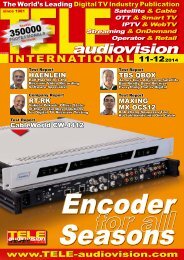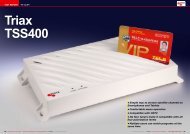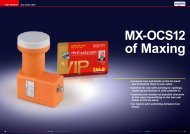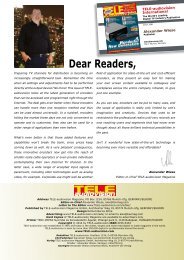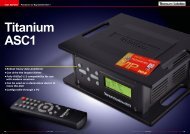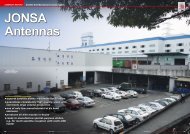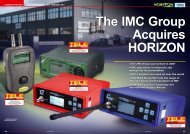eng TELE-audiovision 1409
The World’s Largest Digital TV Trade Magazine
The World’s Largest Digital TV Trade Magazine
Create successful ePaper yourself
Turn your PDF publications into a flip-book with our unique Google optimized e-Paper software.
147<br />
www.<strong>TELE</strong>-<strong>audiovision</strong>.com — 09-10/2014 — <strong>TELE</strong>-<strong>audiovision</strong> International — 全 球 发 行 量 最 大 的 数 字 电 视 杂 志<br />
Smart, Germany - Receivers<br />
www.<strong>TELE</strong>-<strong>audiovision</strong>.com/<strong>TELE</strong>-satellite-0901/smart.pdf<br />
R Manu<br />
R Distr<br />
R Whol<br />
Shop<br />
Serv<br />
<strong>TELE</strong>-satellite World<br />
www.<strong>TELE</strong>-satellite.com/...<br />
Arabic ةيبرعلا www.<strong>TELE</strong>-satellite.com/<strong>TELE</strong>-satellite-0901/ara/smart.pdf<br />
Indonesian Indonesia www.<strong>TELE</strong>-satellite.com/<strong>TELE</strong>-satellite-0901/bid/smart.pdf<br />
Bulgarian Български www.<strong>TELE</strong>-satellite.com/<strong>TELE</strong>-satellite-0901/bul/smart.pdf<br />
Czech Česky www.<strong>TELE</strong>-satellite.com/<strong>TELE</strong>-satellite-0901/ces/smart.pdf<br />
German Deutsch www.<strong>TELE</strong>-satellite.com/<strong>TELE</strong>-satellite-0901/deu/smart.pdf<br />
English English www.<strong>TELE</strong>-satellite.com/<strong>TELE</strong>-satellite-0901/<strong>eng</strong>/smart.pdf<br />
Spanish Español www.<strong>TELE</strong>-satellite.com/<strong>TELE</strong>-satellite-0901/esp/smart.pdf<br />
Farsi يسراف www.<strong>TELE</strong>-satellite.com/<strong>TELE</strong>-satellite-0901/far/smart.pdf<br />
French Français www.<strong>TELE</strong>-satellite.com/<strong>TELE</strong>-satellite-0901/fra/smart.pdf<br />
Greek Ελληνικά www.<strong>TELE</strong>-satellite.com/<strong>TELE</strong>-satellite-0901/hel/smart.pdf<br />
Croatian Hrvatski www.<strong>TELE</strong>-satellite.com/<strong>TELE</strong>-satellite-0901/hrv/smart.pdf<br />
Italian Italiano www.<strong>TELE</strong>-satellite.com/<strong>TELE</strong>-satellite-0901/ita/smart.pdf<br />
Hungarian Magyar www.<strong>TELE</strong>-satellite.com/<strong>TELE</strong>-satellite-0901/mag/smart.pdf<br />
Mandarin 中 文 www.<strong>TELE</strong>-satellite.com/<strong>TELE</strong>-satellite-0901/man/smart.pdf<br />
Dutch Nederlands www.<strong>TELE</strong>-satellite.com/<strong>TELE</strong>-satellite-0901/ned/smart.pdf<br />
Polish Polski www.<strong>TELE</strong>-satellite.com/<strong>TELE</strong>-satellite-0901/pol/smart.pdf<br />
Portuguese Português www.<strong>TELE</strong>-satellite.com/<strong>TELE</strong>-satellite-0901/por/smart.pdf<br />
Romanian Românesc www.<strong>TELE</strong>-satellite.com/<strong>TELE</strong>-satellite-0901/rom/smart.pdf<br />
Russian Русский www.<strong>TELE</strong>-satellite.com/<strong>TELE</strong>-satellite-0901/rus/smart.pdf<br />
Swedish Svenska www.<strong>TELE</strong>-satellite.com/<strong>TELE</strong>-satellite-0901/sve/smart.pdf<br />
Turkish Türkçe www.<strong>TELE</strong>-satellite.com/<strong>TELE</strong>-satellite-0901/tur/smart.pdf<br />
Available online starting from 28 November 2008<br />
Download this report in other languages from the Internet:<br />
■<br />
70 <strong>TELE</strong>-satellite & Broadband — 12-01/2009 — www.<strong>TELE</strong>-satellite.com<br />
Germany, home of the world-famous Black<br />
Forest cuckoo clocks and a by-word for<br />
precision and the art of craftsmanship.<br />
The two Smart managing<br />
directors Peter Löble (left) and<br />
Christoph Hoefler (right) on the<br />
roof of the company’s business<br />
premises. Christoph Hoefler<br />
has been active in the field<br />
of satellite technology since<br />
1988. Starting as a radio and<br />
television technician he moved<br />
on to the purchasing and sales<br />
department of a specialised<br />
electronics store before<br />
starting as field manager for<br />
Nokia. In 2005 he finally became<br />
head of sales at Wela and<br />
with the foundation of Smart<br />
Electronic his new job was<br />
managing director there. Peter<br />
Löble, the second managing<br />
director, has been working in<br />
the satellite field since 1997. He<br />
also worked for an electronics<br />
store and joined Wela in 2001<br />
as product manager. Both have<br />
known each other since 1997<br />
and consider themselves a<br />
great team.<br />
MD<br />
Peter<br />
Löble<br />
<strong>TELE</strong>-satellite World<br />
www.<strong>TELE</strong>-satellite.com/...<br />
Arabic ةيبرعلا www.<strong>TELE</strong>-satellite.com/<strong>TELE</strong>-satellite-0901/ara/smart.pdf<br />
Indonesian Indonesia www.<strong>TELE</strong>-satellite.com/<strong>TELE</strong>-satellite-0901/bid/smart.pdf<br />
Bulgarian Български www.<strong>TELE</strong>-satellite.com/<strong>TELE</strong>-satellite-0901/bul/smart.pdf<br />
Czech Česky www.<strong>TELE</strong>-satellite.com/<strong>TELE</strong>-satellite-0901/ces/smart.pdf<br />
German Deutsch www.<strong>TELE</strong>-satellite.com/<strong>TELE</strong>-satellite-0901/deu/smart.pdf<br />
English English www.<strong>TELE</strong>-satellite.com/<strong>TELE</strong>-satellite-0901/<strong>eng</strong>/smart.pdf<br />
Spanish Español www.<strong>TELE</strong>-satellite.com/<strong>TELE</strong>-satellite-0901/esp/smart.pdf<br />
Farsi يسراف www.<strong>TELE</strong>-satellite.com/<strong>TELE</strong>-satellite-0901/far/smart.pdf<br />
French Français www.<strong>TELE</strong>-satellite.com/<strong>TELE</strong>-satellite-0901/fra/smart.pdf<br />
Greek Ελληνικά www.<strong>TELE</strong>-satellite.com/<strong>TELE</strong>-satellite-0901/hel/smart.pdf<br />
Croatian Hrvatski www.<strong>TELE</strong>-satellite.com/<strong>TELE</strong>-satellite-0901/hrv/smart.pdf<br />
Italian Italiano www.<strong>TELE</strong>-satellite.com/<strong>TELE</strong>-satellite-0901/ita/smart.pdf<br />
Hungarian Magyar www.<strong>TELE</strong>-satellite.com/<strong>TELE</strong>-satellite-0901/mag/smart.pdf<br />
Mandarin 中 文 www.<strong>TELE</strong>-satellite.com/<strong>TELE</strong>-satellite-0901/man/smart.pdf<br />
Dutch Nederlands www.<strong>TELE</strong>-satellite.com/<strong>TELE</strong>-satellite-0901/ned/smart.pdf<br />
Polish Polski www.<strong>TELE</strong>-satellite.com/<strong>TELE</strong>-satellite-0901/pol/smart.pdf<br />
Portuguese Português www.<strong>TELE</strong>-satellite.com/<strong>TELE</strong>-satellite-0901/por/smart.pdf<br />
Romanian Românesc www.<strong>TELE</strong>-satellite.com/<strong>TELE</strong>-satellite-0901/rom/smart.pdf<br />
Russian Русский www.<strong>TELE</strong>-satellite.com/<strong>TELE</strong>-satellite-0901/rus/smart.pdf<br />
Swedish Svenska www.<strong>TELE</strong>-satellite.com/<strong>TELE</strong>-satellite-0901/sve/smart.pdf<br />
Turkish Türkçe www.<strong>TELE</strong>-satellite.com/<strong>TELE</strong>-satellite-0901/tur/smart.pdf<br />
Available online starting from 28 November 2008<br />
Download this report in other languages from the Internet:<br />
■<br />
70 <strong>TELE</strong>-satellite & Broadband — 12-01/2009 — www.<strong>TELE</strong>-satellite.com<br />
journey to the south-western corner of<br />
Germany, home of the world-famous Black<br />
Forest cuckoo clocks and a by-word for<br />
precision and the art of craftsmanship.<br />
The two Smart managing<br />
directors Peter Löble (left) and<br />
Christoph Hoefler (right) on the<br />
roof of the company’s business<br />
premises. Christoph Hoefler<br />
has been active in the field<br />
of satellite technology since<br />
1988. Starting as a radio and<br />
television technician he moved<br />
on to the purchasing and sales<br />
department of a specialised<br />
electronics store before<br />
starting as field manager for<br />
Nokia. In 2005 he finally became<br />
head of sales at Wela and<br />
with the foundation of Smart<br />
Electronic his new job was<br />
managing director there. Peter<br />
Löble, the second managing<br />
director, has been working in<br />
the satellite field since 1997. He<br />
also worked for an electronics<br />
store and joined Wela in 2001<br />
as product manager. Both have<br />
known each other since 1997<br />
and consider themselves a<br />
great team.<br />
MD<br />
Christoph<br />
Hoefler<br />
COMPANY REPORT<br />
<strong>TELE</strong>-satellite World<br />
www.<strong>TELE</strong>-satellite.com/...<br />
Arabic ةيبرعلا www.<strong>TELE</strong>-satellite.com/<strong>TELE</strong>-satellite-0901/ara/smart.pdf<br />
Indonesian Indonesia www.<strong>TELE</strong>-satellite.com/<strong>TELE</strong>-satellite-0901/bid/smart.pdf<br />
Bulgarian Български www.<strong>TELE</strong>-satellite.com/<strong>TELE</strong>-satellite-0901/bul/smart.pdf<br />
Czech Česky www.<strong>TELE</strong>-satellite.com/<strong>TELE</strong>-satellite-0901/ces/smart.pdf<br />
German Deutsch www.<strong>TELE</strong>-satellite.com/<strong>TELE</strong>-satellite-0901/deu/smart.pdf<br />
English English www.<strong>TELE</strong>-satellite.com/<strong>TELE</strong>-satellite-0901/<strong>eng</strong>/smart.pdf<br />
Spanish Español www.<strong>TELE</strong>-satellite.com/<strong>TELE</strong>-satellite-0901/esp/smart.pdf<br />
Farsi يسراف www.<strong>TELE</strong>-satellite.com/<strong>TELE</strong>-satellite-0901/far/smart.pdf<br />
French Français www.<strong>TELE</strong>-satellite.com/<strong>TELE</strong>-satellite-0901/fra/smart.pdf<br />
Greek Ελληνικά www.<strong>TELE</strong>-satellite.com/<strong>TELE</strong>-satellite-0901/hel/smart.pdf<br />
Croatian Hrvatski www.<strong>TELE</strong>-satellite.com/<strong>TELE</strong>-satellite-0901/hrv/smart.pdf<br />
Italian Italiano www.<strong>TELE</strong>-satellite.com/<strong>TELE</strong>-satellite-0901/ita/smart.pdf<br />
Hungarian Magyar www.<strong>TELE</strong>-satellite.com/<strong>TELE</strong>-satellite-0901/mag/smart.pdf<br />
Mandarin 中 文 www.<strong>TELE</strong>-satellite.com/<strong>TELE</strong>-satellite-0901/man/smart.pdf<br />
Dutch Nederlands www.<strong>TELE</strong>-satellite.com/<strong>TELE</strong>-satellite-0901/ned/smart.pdf<br />
Polish Polski www.<strong>TELE</strong>-satellite.com/<strong>TELE</strong>-satellite-0901/pol/smart.pdf<br />
Portuguese Português www.<strong>TELE</strong>-satellite.com/<strong>TELE</strong>-satellite-0901/por/smart.pdf<br />
Romanian Românesc www.<strong>TELE</strong>-satellite.com/<strong>TELE</strong>-satellite-0901/rom/smart.pdf<br />
Russian Русский www.<strong>TELE</strong>-satellite.com/<strong>TELE</strong>-satellite-0901/rus/smart.pdf<br />
Swedish Svenska www.<strong>TELE</strong>-satellite.com/<strong>TELE</strong>-satellite-0901/sve/smart.pdf<br />
Turkish Türkçe www.<strong>TELE</strong>-satellite.com/<strong>TELE</strong>-satellite-0901/tur/smart.pdf<br />
Available online starting from 28 November 2008<br />
Download this report in other languages from the Internet:<br />
■<br />
70 <strong>TELE</strong>-satellite & Broadband — 12-01/2009 — www.<strong>TELE</strong>-satellite.com<br />
Being ‘SMART’<br />
in Germany’s<br />
Black Forest<br />
Receiver Manufacturer Smart<br />
When you hold this issue of <strong>TELE</strong>-satellite in<br />
your hands the company Smart Electronic<br />
will only have been in existence for less<br />
than a year. It doubtlessly is a very young<br />
company, but still it can boast its own<br />
production facilities and dedicated sales<br />
channels. How can a start-up business<br />
develop so fast? That’s exactly what we<br />
wanted to findoutwhenwesetoutonour<br />
journey to the south-western corner of<br />
Germany, home of the world-famous Black<br />
Forest cuckoo clocks and a by-word for<br />
precision and the art of craftsmanship.<br />
The two Smart managing<br />
directors Peter Löble (left) and<br />
Christoph Hoefler (right) on the<br />
roof of the company’s business<br />
premises. Christoph Hoefler<br />
has been active in the field<br />
of satellite technology since<br />
1988. Starting as a radio and<br />
television technician he moved<br />
on to the purchasing and sales<br />
department of a specialised<br />
electronics store before<br />
starting as field manager for<br />
Nokia. In 2005 he finally became<br />
head of sales at Wela and<br />
with the foundation of Smart<br />
Electronic his new job was<br />
managing director there. Peter<br />
Löble, the second managing<br />
director, has been working in<br />
the satellite field since 1997. He<br />
also worked for an electronics<br />
store and joined Wela in 2001<br />
as product manager. Both have<br />
known each other since 1997<br />
and consider themselves a<br />
great team.<br />
■<br />
72 <strong>TELE</strong>-satellite & Broadband — 12-01/2009 — www.<strong>TELE</strong>-satellite.com<br />
Christoph Hoefler und Peter Löble are<br />
the two managing directors of Smart and<br />
they give a brief account of the run-up to<br />
the current business: Smart Electronic<br />
was spun off of the long-running trading<br />
company Wela Electronic at the beginning<br />
of 2008. At the same time Smart also took<br />
over a fully operational manufacturing site<br />
for assembling satellite receivers from<br />
third-party components. Incidentally, satellite<br />
receivers make up only one segment<br />
of the complete product range. “We also<br />
supply LNBs, multi-switches and mounting<br />
material, which means we can offer everything<br />
a specialised satellite dealer needs,”<br />
explains Peter Löble.<br />
Christoph Hoefler then continues by providing<br />
some insight into how the company<br />
performed in the first year of business.<br />
“We had anticipated a first-year turnover<br />
along the lines of 20 million EUR, with a<br />
10% increase for 2009.” All employees<br />
that had been involved in satellite technology<br />
were taken over from Wela Electronic.<br />
According to Christoph Hoefler “30<br />
employees work in receiver manufacturing,<br />
while 15 members of staff take care of<br />
sales and 10 persons work in administration.”<br />
The marketing department was set<br />
up from scratch and already has a head<br />
count of four members of staff. Smart is in<br />
expansion mode, that’s for sure!<br />
So what are the actual goals of expansion?<br />
Peter Löble summarises the company’s<br />
markets as follows. “Some 50%<br />
of sales are generated in Germany, 20%<br />
each go to Western and Eastern Europe<br />
and 10% to North Africa.” For 2009 Peter<br />
Löble expects some shifting of markets in<br />
combination with increased turnover. “We<br />
believe that 45% of our sales will go to<br />
Germany, 15% to Western Europe, 25%<br />
to Eastern Europe and the North African<br />
share will rise to 15% as well.”<br />
He also explains why he is so optimistic<br />
about the development of sales in Northern<br />
Africa: “A few months ago we set up<br />
a branch there which means we are now<br />
able to supply our customers in that region<br />
very quickly and with reduced turnaround<br />
times.”<br />
Smart has a clear focus on receiver<br />
production, and this is a segment where<br />
the two managing directors also identify<br />
the core str<strong>eng</strong>ths of Smart. Christoph<br />
Hoefler: “We are able to react swiftly to<br />
customer demands, because we manufacture<br />
our receivers right here in the Black<br />
Forest region and therefore are not faced<br />
with long and winding delivery channels<br />
for our customers in Europe and Northern<br />
Africa.”<br />
Christoph Hoefele lists some examples:<br />
“Depending on the required language<br />
we package the appropriate instruction<br />
manual or adapt the on-screen menu to the<br />
local language.” After all, Smart lives by its<br />
credo “Connect, watch”. Customers need<br />
to be happy with their Smart receiver right<br />
from the start, which can be guaranteed by<br />
“usability in combination with quality made<br />
in the Black Forest,” according to Christoph<br />
Hoefler,whohitsthecoreoftheSmartphilosophy<br />
with this statement.<br />
Peter Löble visits the sales office<br />
in<br />
Morocco almost on a monthly basis and<br />
he adds that “Smart is open for new sales<br />
partners mainly in Europe, but also in non-<br />
European countries. We are able to adapt<br />
our receivers to local requirements very<br />
quickly,” he hastens to add.<br />
Even though Smart has only been in<br />
existence for less than a year the company<br />
is already in the process of developing new<br />
products. Some of these will already be<br />
available by the time this issue of <strong>TELE</strong>satellite<br />
is published. “We’re introducing<br />
a new LNB series with extremely small<br />
dimensions,” reveals Peter Löble. And<br />
View of the production floor: here, the components sourced as cabinets are equipped with tuners.<br />
Explains Peter Löble: “This way we are able to cover several markets with a single base unit, depending<br />
on the individual market demands and with the added advantage of being able to guarantee quality<br />
assurance.” Three product ranges are manufactured here: fully fledged HD receivers with CA, CI, USB<br />
and VFD display, basic models with limited features and – recently added – LINUX-based receivers.<br />
Spaun, Germany - Accessories<br />
www.<strong>TELE</strong>-<strong>audiovision</strong>.com/<strong>TELE</strong>-satellite-0811/spaun.pdf<br />
R Manu<br />
Distr<br />
Whol<br />
Shop<br />
Serv<br />
IBC<br />
Certificate<br />
Holder<br />
■<br />
■<br />
■<br />
■<br />
■<br />
66 <strong>TELE</strong>-satellite & Broadband — 10-11/2008 — www.<strong>TELE</strong>-satellite.com<br />
Quality to Measure<br />
Every multiswitch is tested on multiple functions.<br />
The multiswitch is inserted into this test station and<br />
by moving a single lever all of the “F” connectors are<br />
inserted and the test process can be started.<br />
Spaun employee Peter Fuchs shows us the testing process on a model 17 test station, the largest of the ten<br />
test stations used by Spaun. “In the past a complete test required 50 minutes”, explains Peter Fuchs, “today only<br />
three minutes is needed to automatically test every function.<br />
After the completion of the testing process, the<br />
PC prints a serial number which is then attached<br />
to the device. The test results are archived so that<br />
Spaun can recall the test results for any individual<br />
multiswitch.<br />
Finished:<br />
Friedrich Spaun with a<br />
completed<br />
multiswitch:<br />
“We have been adding<br />
serial numbers to our<br />
products since 2005”, he<br />
explains about their quality<br />
assurance.<br />
Using the serial number<br />
for Internet inquiries is<br />
thought about. In this way<br />
it would be very easy to<br />
identify plagiarized products.<br />
Even if a Spaun multiswitch passes all of its electronic<br />
tests perfectly, it still isn’t clear if it is technically<br />
sound.<br />
This part is checked here: every multiswitch is<br />
placed with its power supply in this high voltage test<br />
chamber. In this way Spaun can guarantee that the<br />
completed multiswitch is 100% perfect.<br />
They are so sure that they provide a 5-year guarantee.<br />
“In reality”, explains Friedrich Spaun, “we<br />
repair products that are older than five years.”<br />
It’s very simple, there are so few of them that the<br />
warranty period could be extended, “but for legal<br />
reasons we keep it at five years”, explains Friedrich<br />
Spaun.<br />
Founder<br />
Friedrich<br />
Spaun<br />
■<br />
■<br />
68 <strong>TELE</strong>-satellite — Global Digital TV Magazine — 10-11/2010 — www.<strong>TELE</strong>-satellite.com<br />
Power Supply Units Made by<br />
SPAUN – guaranteed!<br />
Every multi-switch and every amplifier comes<br />
with one, and of course every receiver has one,<br />
too: a power supply unit which is required to<br />
connect the device to the mains. It has become<br />
such an everyday component of virtually any<br />
electronic device that we have stopped thinking<br />
about how it actually works. SPAUN, on the other<br />
hand, has given it a great deal of thought and<br />
has arrived at a remarkable conclusion. Kevin<br />
Spaun is the managing director of SPAUN, one<br />
of the most renowned quality manufactures of<br />
multi-switches and other accessories for satellite<br />
signal distribution. He tells us what it‘s all about.<br />
SPAUN administration office<br />
(front) and production premises<br />
(right) in Singen, southwest<br />
Germany<br />
Kevin Spaun, managing<br />
director of SPAUN POWER GmbH<br />
MD<br />
Kevin<br />
Spaun<br />
■<br />
■<br />
■<br />
60 <strong>TELE</strong>-satellite & Broadband — 10-11/2008 — www.<strong>TELE</strong>-satellite.com<br />
He then explained how Spaun ended up with<br />
their company colors: “Those are the colors<br />
of the building walls, blue and silver, and we<br />
decided to incorporate these colors into our<br />
corporate identity.”<br />
Spaun has only existed as a stand-alone<br />
brand name since 1991. That was after the<br />
fall of the Berlin Wall. Up to that point Spaun<br />
only delivered their products to West Germany;<br />
there was no real thought of exporting<br />
products. The new market in eastern<br />
Germany brought with it so many new<br />
opportunities that Friedrich Spaun finally<br />
decided: “We are now going to distribute<br />
products under our own brand name!”<br />
In 1993 his first successful product was<br />
a multiswitch for two satellites and one<br />
terrestrial TV input followed soon after by<br />
four and eight satellite input models. These<br />
products were quickly exported to neighboring<br />
countries. Today 50 % of their products<br />
are exported of which 30 % are shipped to<br />
EU countries with 20 % ending up outside of<br />
Europe. Total sales for Spaun range between<br />
12 and 15 million Euros each year.<br />
This is where Kevin Spaun comes into<br />
the picture. He took over company operations<br />
from his father Friedrich Spaun in early<br />
2008. “But we run the company as a team”,<br />
confirmed both of them at the same time.<br />
Kevin Spaun wants to expand the export<br />
business: “At the moment we are in the<br />
process of locking in the North American<br />
market; we are looking for local distributors<br />
and also want to open our own distribution<br />
officeintheUSA”,revealsKevinSpaun,“we<br />
also want a stronger presence in the Middle<br />
East.“<br />
Spaun offers nearly 200 different products<br />
of which the best-selling products are,<br />
and always have been, multiswitches avail-<br />
A customer has a problem. Steffen Kuck is Technical Support<br />
Manager and helps Spaun’s customers daily from 8AM to 12PM<br />
and from 1PM to 5PM. One of his tools is the SatcoDX CD-ROM<br />
with its worldwide satellite data.<br />
An important communications<br />
medium is of course the<br />
Internet. Web designer Patrick<br />
Keil is seen here looking over<br />
visitors to www.spaun.de.<br />
“We have about 40,000 visitors<br />
every month”, explains<br />
Patrick Keil. On the monitor<br />
he shows us the current website<br />
visitors. Thanks to Geomapping,<br />
he knows exactly<br />
where these visitors come<br />
from and can communicate<br />
with each one of them with a<br />
pop up window. The surprise:<br />
this program was developed<br />
together by Kevin Spaun and<br />
Patrick Keil and the best part<br />
– it is freeware and can be<br />
used by anyone who wants to<br />
get more detailed information<br />
on who is visiting their web<br />
site, how long they have been<br />
there, what they are looking at<br />
and where they come from, and<br />
all of this live! Here is the link:<br />
www.livezilla.net<br />
Spaun general Manager Kevin Spaun also likes to get his hands<br />
dirty sometimes by testing multiswitches.<br />
The antenna signals from the roof land here and can be connected<br />
to the multiswitches in any arrangement. Customer problems can<br />
also be replicated and then checked out here.<br />
Technical<br />
Manager<br />
Steffen<br />
Kuck<br />
COMPANY REPORT<br />
■<br />
58 <strong>TELE</strong>-satellite & Broadband — 10-11/2008 — www.<strong>TELE</strong>-satellite.com<br />
Moving into the new decade<br />
with many new products<br />
Alexander Wiese<br />
High Quality Accessory Manufacturer<br />
Spaun at 40 years<br />
Almost every <strong>TELE</strong>-satellite reader will associate<br />
the name Spaun with high-quality satellite<br />
distribution components. “Quality made in Germany”<br />
is their motto; Spaun’s mission in life is<br />
to make sure that the quality of their products<br />
is always kept at the highest level.<br />
But more on that later. Let’s take a closer look<br />
at Spaun itself: they are a company that can be<br />
found in extreme southwestern Germany. The<br />
founder of the company, that today has nearly<br />
100 employees, is Friedrich Spaun. He explained<br />
to us how it all started: “It all began for me on<br />
my kitchen table in 1969.” Back then FM radio<br />
in Germany was just starting to transmit in<br />
stereo. It quickly became clear that many of<br />
the radios in use were not getting enough of an<br />
antenna signal - an amplifier was needed that<br />
would raise the signal-to-noise ratio. “I constructed<br />
an amplifierboardthatwasinstalledin<br />
the indoor antennas supplied by a large manufacturer”,<br />
remembers Friedrich Spaun. It was<br />
the start of his one-man company.<br />
In 1972 his little company was so successful<br />
that he was able to hire his first employees. “In<br />
1974 real production of multi-range amplifiers<br />
and passive distributors was started”, Friedrich<br />
Spaun recalls. Of course back then these<br />
were components for terrestrial television and<br />
Spaun was only an OEM manufacturer for other<br />
German firms. In 1980 supply line amplifiers for<br />
cable TV were added to the mix.<br />
Thus far production took place in a rented<br />
house, but that all changed in 1988: “That’s<br />
when we built our production facility in Singen<br />
that we still work out of today and were also at<br />
the same time a pioneer”, comments Friedrich<br />
Spaun as he shows us the outside walls made<br />
of aluminum: “For many years we were a reference<br />
point for the manufacturer of these walls.”<br />
Well, actually, the title isn’t quite correct; the company Spaun doesn’t celebrate its 40th<br />
anniversary until 2009. But Spaun is so full of energy and is getting ready to introduce<br />
a wide range of new products in their anniversary year that we simply couldn’t wait to<br />
find out about this company’s long history.<br />
A look at the office building of company Spaun in Singen<br />
in southwestern Germany. Behind the building to the right<br />
can be found the production facilities for Spaun’s multiswitches.<br />
<strong>TELE</strong>-satellite World<br />
www.<strong>TELE</strong>-satellite.com/...<br />
Arabic ةيبرعلا www.<strong>TELE</strong>-satellite.com/<strong>TELE</strong>-satellite-0811/ara/spaun.pdf<br />
Indonesian Indonesia www.<strong>TELE</strong>-satellite.com/<strong>TELE</strong>-satellite-0811/bid/spaun.pdf<br />
Bulgarian Български www.<strong>TELE</strong>-satellite.com/<strong>TELE</strong>-satellite-0811/bul/spaun.pdf<br />
Czech Česky www.<strong>TELE</strong>-satellite.com/<strong>TELE</strong>-satellite-0811/ces/spaun.pdf<br />
German Deutsch www.<strong>TELE</strong>-satellite.com/<strong>TELE</strong>-satellite-0811/deu/spaun.pdf<br />
English English www.<strong>TELE</strong>-satellite.com/<strong>TELE</strong>-satellite-0811/<strong>eng</strong>/spaun.pdf<br />
Spanish Español www.<strong>TELE</strong>-satellite.com/<strong>TELE</strong>-satellite-0811/esp/spaun.pdf<br />
Farsi يسراف www.<strong>TELE</strong>-satellite.com/<strong>TELE</strong>-satellite-0811/far/spaun.pdf<br />
French Français www.<strong>TELE</strong>-satellite.com/<strong>TELE</strong>-satellite-0811/fra/spaun.pdf<br />
Greek Ελληνικά www.<strong>TELE</strong>-satellite.com/<strong>TELE</strong>-satellite-0811/hel/spaun.pdf<br />
Croatian Hrvatski www.<strong>TELE</strong>-satellite.com/<strong>TELE</strong>-satellite-0811/hrv/spaun.pdf<br />
Italian Italiano www.<strong>TELE</strong>-satellite.com/<strong>TELE</strong>-satellite-0811/ita/spaun.pdf<br />
Hungarian Magyar www.<strong>TELE</strong>-satellite.com/<strong>TELE</strong>-satellite-0811/mag/spaun.pdf<br />
Mandarin 中 文 www.<strong>TELE</strong>-satellite.com/<strong>TELE</strong>-satellite-0811/man/spaun.pdf<br />
Dutch Nederlands www.<strong>TELE</strong>-satellite.com/<strong>TELE</strong>-satellite-0811/ned/spaun.pdf<br />
Polish Polski www.<strong>TELE</strong>-satellite.com/<strong>TELE</strong>-satellite-0811/pol/spaun.pdf<br />
Portuguese Português www.<strong>TELE</strong>-satellite.com/<strong>TELE</strong>-satellite-0811/por/spaun.pdf<br />
Romanian Românesc www.<strong>TELE</strong>-satellite.com/<strong>TELE</strong>-satellite-0811/rom/spaun.pdf<br />
Russian Русский www.<strong>TELE</strong>-satellite.com/<strong>TELE</strong>-satellite-0811/rus/spaun.pdf<br />
Swedish Svenska www.<strong>TELE</strong>-satellite.com/<strong>TELE</strong>-satellite-0811/sve/spaun.pdf<br />
Turkish Türkçe www.<strong>TELE</strong>-satellite.com/<strong>TELE</strong>-satellite-0811/tur/spaun.pdf<br />
Available online starting from 26 September 2008<br />
Download this report in other languages from the Internet:<br />
■<br />
59<br />
www.<strong>TELE</strong>-satellite.com — 10-11/2008 — <strong>TELE</strong>-satellite & Broadband<br />
Kevin Spaun (left), General Manager,<br />
and Friedrich Spaun, Founder, on the<br />
roof of their office building. Both of<br />
them operate Spaun as a team.<br />
Stab, Italy - Motors<br />
www.<strong>TELE</strong>-<strong>audiovision</strong>.com/<strong>TELE</strong>-satellite-0809/stab.pdf<br />
R Manu<br />
Distr<br />
Whol<br />
Shop<br />
Serv<br />
COMPANY REPORT<br />
▲<br />
Happy<br />
Birthday<br />
10 Years<br />
58 <strong>TELE</strong>-satellite & Broadband — 08-09/2008 — www.<strong>TELE</strong>-satellite.com<br />
Motor Control<br />
The birthday boy himself: Giorgio Bergamini<br />
is the founder of the USALS program that is<br />
celebrating its 10th anniversary in 2008.<br />
Founder<br />
Giorgio<br />
Bergamini<br />
COMPANY REPORT<br />
▲<br />
Happy<br />
Birthday<br />
10 Years<br />
58 <strong>TELE</strong>-satellite & Broadband — 08-09/2008 — www.<strong>TELE</strong>-satellite.com<br />
Motor Control<br />
The birthday boy himself: Giorgio Bergamini<br />
is the founder of the USALS program that is<br />
celebrating its 10th anniversary in 2008.<br />
▲<br />
60 <strong>TELE</strong>-satellite & Broadband — 08-09/2008 — www.<strong>TELE</strong>-satellite.com<br />
Sandro Gnani is a STAB technician who checks each sample receiver to make sure that USALS<br />
has been correctly implemented. The manufacturer can only print the USALS logo on the receiver<br />
and its packaging when the receiver has passed every test.<br />
USALS<br />
Celebrates<br />
10 Years<br />
Alexander Wiese<br />
Every <strong>TELE</strong>-satellite reader is familiar<br />
with the term USALS. In the Technical<br />
Data table of every receiver test report<br />
there is a line that identifies whether or not<br />
the receiver is USALS compatible. Today,<br />
almost every receiver on the market comes<br />
with USALS. But USALS is not just a group<br />
of letters; there’s actually a human behind<br />
this term!<br />
USALS stands for “Universal Satellite<br />
Automatic Location System” and is software<br />
that was developed exactly ten years ago<br />
by Giorgio Bergamini. But it would be much<br />
better to hear the story from the birthday<br />
boy himself so off to Italy we go near Ferrara<br />
located about equidistant from Bologna<br />
and Venice. STAB’s headquarters and<br />
production facility can be found there and<br />
Giorgio Bergamini is the founder and owner<br />
of STAB, a company that has been in existence<br />
since 1970.<br />
STAB started early on building antenna<br />
motors. In the beginning it was rotors for<br />
VHF/UHF TV antennas and when satellite<br />
reception became popular in the 1990’s,<br />
they expanded to offering an assortment<br />
of satellite antenna motors. “It was 1995”,<br />
remembers Giorgio Bergamini, when a few<br />
of the early satellite receiver manufacturers<br />
got together with EUTELSAT and developed<br />
the DiSEqC protocol. In 1997 it was<br />
officially introduced and included DiSEqC<br />
1.0 for individual LNBs, DiSEqC 1.1 for two<br />
LNBs and, DiSEqC 1.2 for antenna motors.<br />
But it was quickly discovered that the<br />
1.2 protocol could only be used on a limited<br />
basis: it required the storing of satellite<br />
positions in the motor and this turned<br />
out to be useless when the motor was used<br />
anywhere in the southern hemisphere.<br />
The dishes there are pointed to the north<br />
and not to the south. As a result, the order<br />
of satellites was no longer correct – it was<br />
now backwards compared to the northern<br />
hemisphere.<br />
“In 1998 I had an idea: the positions<br />
should no longer be stored in the motor<br />
but instead in the receiver”, remembers<br />
Giorgio. This was the birth of USALS. He<br />
wrote a small, but effective software program<br />
that with the help of<br />
only the local geographical position on the<br />
Earth and a reference satellite was able to<br />
calculate all the other satellite positions<br />
directly in the receiver, and it didn’t matter<br />
if you were in the northern or southern<br />
hemisphere.<br />
Finally, in January 2000, EUTELSAT officially<br />
recognized USALS and introduced<br />
it as DiSEqC 1.3. It is identical to DiSEqC<br />
1.2 but includes an additional line of code:<br />
“Drive Motor to Angular Position”.<br />
Subur Semesta, Indonesia - Dishes<br />
www.<strong>TELE</strong>-<strong>audiovision</strong>.com/<strong>TELE</strong>-satellite-0805/subursemesta.pdf<br />
R Manu<br />
Distr<br />
Whol<br />
Shop<br />
Serv<br />
▲ ▲<br />
te & Broadband — 04-05/2008 — www.<strong>TELE</strong>-satellite.com<br />
ny PT Subur Semesta was founded in 1978 in<br />
ava, one of the 17,000 islands that make up Indonethe<br />
220 million inhabitants can be found on Java of<br />
lion live in the capital city Jakarta – it could even be<br />
more. To be noticed here you need an extremely<br />
nd it is for that reason that PT Subur Semesta uses<br />
enus as their trademark. The wonderful ambiguity<br />
d of Love Venus can only make you smile. One of<br />
of the company, Liong Ten Fook, came up with the<br />
genious idea!<br />
Ten Fook was not<br />
nder; his partner<br />
n and still is now<br />
g An. “We origias<br />
a telephone<br />
ctory. Later on we<br />
gency lights, that<br />
h built in batterused<br />
everywhere<br />
ere is a power<br />
embers Liong Ten<br />
Semesta entered<br />
arena in 1989<br />
began to offer<br />
llite receivers. In<br />
st digital receiver<br />
d in 2002 it all<br />
serious when the<br />
f satellite dishes<br />
he meantime the<br />
panded its mana<br />
Tek Ijoe climbed<br />
partner. Today PT<br />
ta is run by these<br />
rs.<br />
mount of money<br />
in 2004 explains<br />
: “We acquired a<br />
s so that we could<br />
the dish segments<br />
Heavy investment<br />
ny occurred again<br />
er: “We bought a<br />
nting system to<br />
he segments.”<br />
still not enough.<br />
e revealed to us<br />
yet another large<br />
“We<br />
invested<br />
600,000 for the<br />
f mesh antennas.<br />
produce 20,000<br />
month.”<br />
In western Jakarta, not too far<br />
from the international airport,<br />
can be found PT Subur Semesta,<br />
brand name Venus.<br />
The officesareatthefrontof<br />
the building with the windows, and<br />
towards the back are the factory<br />
buildings that house the machines<br />
to manufacture the dish antennas.<br />
The company employs a total of 200<br />
people of which 60 are involved with<br />
the manufacture of dishes. They<br />
work from 8AM to 5PM Monday thru<br />
Friday and on Saturdays to 2PM.<br />
PT Subur Semesta’s three<br />
partners: From the left,<br />
Liong Ten Fook, Finance<br />
Director, Tjia Tek Ijoe, Managing<br />
Director, and Thiang Tiong An,<br />
Technical Director<br />
Those are large numbers; we<br />
wanted to know how many solid<br />
antennas are being manufactured<br />
today: “At the moment,<br />
our production capacity is at<br />
about 15,000 antennas per<br />
month of which the majority are<br />
sold domestically”, explained<br />
Thiang Tiong An, “Our company<br />
supplies approximately 15% of<br />
the Indonesian market.”<br />
Of their total production,<br />
80% is delivered domestically,<br />
the rest is exported. According<br />
to Thiang Tiong An, “40% of our<br />
dish production goes to Thailand<br />
and Vietnam, the remainder<br />
goes to Brunei with a small<br />
percentage going to Australia.”<br />
“Naturally we want to expand<br />
our exports”, explains Tjia Tek<br />
Ijoe, “We are investing heavily<br />
in quality.” PT Subur Semesta<br />
MD<br />
Tjia<br />
Tek Ijoe<br />
▲ ▲<br />
56 <strong>TELE</strong>-satellite & Broadband — 04-05/2008 — www.<strong>TELE</strong>-satellite.com<br />
The company PT Subur Semesta was founded in 1978 in<br />
Jakarta on Java, one of the 17,000 islands that make up Indonesia.<br />
60% of the 220 million inhabitants can be found on Java of<br />
which 15 million live in the capital city Jakarta – it could even be<br />
a few million more. To be noticed here you need an extremely<br />
bright star and it is for that reason that PT Subur Semesta uses<br />
the planet Venus as their trademark. The wonderful ambiguity<br />
with the God of Love Venus can only make you smile. One of<br />
the founders of the company, Liong Ten Fook, came up with the<br />
name – an ingenious idea!<br />
But Liong Ten Fook was not<br />
the only founder; his partner<br />
was back then and still is now<br />
Thiang Tiong An. “We originally<br />
started as a telephone<br />
accessory factory. Later on we<br />
added emergency lights, that<br />
is, lights with built in batteries<br />
that are used everywhere<br />
whenever there is a power<br />
outage”, remembers Liong Ten<br />
Fook.<br />
PT Subur Semesta entered<br />
the satellite arena in 1989<br />
when they began to offer<br />
analog satellite receivers. In<br />
2000 the first digital receiver<br />
appeared and in 2002 it all<br />
turned really serious when the<br />
production of satellite dishes<br />
began. In the meantime the<br />
company expanded its management:<br />
Tjia Tek Ijoe climbed<br />
aboard as a partner. Today PT<br />
Subur Semesta is run by these<br />
three partners.<br />
A large amount of money<br />
was invested in 2004 explains<br />
Tjia Tek Ijoe: “We acquired a<br />
machine press so that we could<br />
manufacture the dish segments<br />
ourselves.” Heavy investment<br />
in the company occurred again<br />
one year later: “We bought a<br />
powder painting system to<br />
spray paint the segments.”<br />
But it was still not enough.<br />
Tjia Tek Ijoe revealed to us<br />
that there’s yet another large<br />
investment: “We invested<br />
another USD 600,000 for the<br />
fabrication of mesh antennas.<br />
This lets us produce 20,000<br />
dishes every month.”<br />
In western Jakarta, not too far<br />
from the international airport,<br />
can be found PT Subur Semesta,<br />
brand name Venus.<br />
The officesareatthefrontof<br />
the building with the windows, and<br />
towards the back are the factory<br />
buildings that house the machines<br />
to manufacture the dish antennas.<br />
The company employs a total of 200<br />
people of which 60 are involved with<br />
the manufacture of dishes. They<br />
work from 8AM to 5PM Monday thru<br />
Friday and on Saturdays to 2PM.<br />
PT Subur Semesta’s three<br />
partners: From the left,<br />
Liong Ten Fook, Finance<br />
Director, Tjia Tek Ijoe, Managing<br />
Director, and Thiang Tiong An,<br />
Technical Director<br />
Those are large numbers; we<br />
wanted to know how many solid<br />
antennas are being manufactured<br />
today: “At the moment,<br />
our production capacity is at<br />
about 15,000 antennas per<br />
month of which the majority are<br />
sold domestically”, explained<br />
Thiang Tiong An, “Our company<br />
supplies approximately 15% of<br />
the Indonesian market.”<br />
Of their total production,<br />
80% is delivered domestically,<br />
the rest is exported. According<br />
to Thiang Tiong An, “40% of our<br />
dish production goes to Thailand<br />
and Vietnam, the remainder<br />
goes to Brunei with a small<br />
percentage going to Australia.”<br />
“Naturally we want to expand<br />
our exports”, explains Tjia Tek<br />
Ijoe, “We are investing heavily<br />
in quality.” PT Subur Semesta<br />
Finance<br />
Liong<br />
Ten Fook<br />
▲ ▲<br />
56 <strong>TELE</strong>-satellite & Broadband — 04-05/2008 — www.<strong>TELE</strong>-satellite.com<br />
The company PT Subur Semesta was founded in 1978 in<br />
Jakarta on Java, one of the 17,000 islands that make up Indonesia.<br />
60% of the 220 million inhabitants can be found on Java of<br />
which 15 million live in the capital city Jakarta – it could even be<br />
a few million more. To be noticed here you need an extremely<br />
bright star and it is for that reason that PT Subur Semesta uses<br />
the planet Venus as their trademark. The wonderful ambiguity<br />
with the God of Love Venus can only make you smile. One of<br />
the founders of the company, Liong Ten Fook, came up with the<br />
name – an ingenious idea!<br />
But Liong Ten Fook was not<br />
the only founder; his partner<br />
was back then and still is now<br />
Thiang Tiong An. “We originally<br />
started as a telephone<br />
accessory factory. Later on we<br />
added emergency lights, that<br />
is, lights with built in batteries<br />
that are used everywhere<br />
whenever there is a power<br />
outage”, remembers Liong Ten<br />
Fook.<br />
PT Subur Semesta entered<br />
the satellite arena in 1989<br />
when they began to offer<br />
analog satellite receivers. In<br />
2000 the first digital receiver<br />
appeared and in 2002 it all<br />
turned really serious when the<br />
production of satellite dishes<br />
began. In the meantime the<br />
company expanded its management:<br />
Tjia Tek Ijoe climbed<br />
aboard as a partner. Today PT<br />
Subur Semesta is run by these<br />
three partners.<br />
A large amount of money<br />
was invested in 2004 explains<br />
Tjia Tek Ijoe: “We acquired a<br />
machine press so that we could<br />
manufacture the dish segments<br />
ourselves.” Heavy investment<br />
in the company occurred again<br />
one year later: “We bought a<br />
powder painting system to<br />
spray paint the segments.”<br />
But it was still not enough.<br />
Tjia Tek Ijoe revealed to us<br />
that there’s yet another large<br />
investment: “We invested<br />
another USD 600,000 for the<br />
fabrication of mesh antennas.<br />
This lets us produce 20,000<br />
dishes every month.”<br />
In western Jakarta, not too far<br />
from the international airport,<br />
can be found PT Subur Semesta,<br />
brand name Venus.<br />
The officesareatthefrontof<br />
the building with the windows, and<br />
towards the back are the factory<br />
buildings that house the machines<br />
to manufacture the dish antennas.<br />
The company employs a total of 200<br />
people of which 60 are involved with<br />
the manufacture of dishes. They<br />
work from 8AM to 5PM Monday thru<br />
Friday and on Saturdays to 2PM.<br />
PT Subur Semesta’s three<br />
partners: From the left,<br />
Liong Ten Fook, Finance<br />
Director, Tjia Tek Ijoe, Managing<br />
Director, and Thiang Tiong An,<br />
Technical Director<br />
Those are large numbers; we<br />
wanted to know how many solid<br />
antennas are being manufactured<br />
today: “At the moment,<br />
our production capacity is at<br />
about 15,000 antennas per<br />
month of which the majority are<br />
sold domestically”, explained<br />
Thiang Tiong An, “Our company<br />
supplies approximately 15% of<br />
the Indonesian market.”<br />
Of their total production,<br />
80% is delivered domestically,<br />
the rest is exported. According<br />
to Thiang Tiong An, “40% of our<br />
dish production goes to Thailand<br />
and Vietnam, the remainder<br />
goes to Brunei with a small<br />
percentage going to Australia.”<br />
“Naturally we want to expand<br />
our exports”, explains Tjia Tek<br />
Ijoe, “We are investing heavily<br />
in quality.” PT Subur Semesta<br />
Technical<br />
Thiang<br />
Tiong An<br />
COMPANY REPORT<br />
▲ ▲<br />
56 <strong>TELE</strong>-satellite & Broadband — 04-05/2008 — www.<strong>TELE</strong>-satellite.com<br />
Jakarta’s<br />
Venus Star<br />
Dish Manufacturer PT Subur Semesta, Indonesia<br />
The company PT Subur Semesta was founded in 1978 in<br />
Jakarta on Java, one of the 17,000 islands that make up Indonesia.<br />
60% of the 220 million inhabitants can be found on Java of<br />
which 15 million live in the capital city Jakarta – it could even be<br />
a few million more. To be noticed here you need an extremely<br />
bright star and it is for that reason that PT Subur Semesta uses<br />
the planet Venus as their trademark. The wonderful ambiguity<br />
with the God of Love Venus can only make you smile. One of<br />
the founders of the company, Liong Ten Fook, came up with the<br />
name – an ingenious idea!<br />
But Liong Ten Fook was not<br />
the only founder; his partner<br />
was back then and still is now<br />
Thiang Tiong An. “We originally<br />
started as a telephone<br />
accessory factory. Later on we<br />
added emergency lights, that<br />
is, lights with built in batteries<br />
that are used everywhere<br />
whenever there is a power<br />
outage”, remembers Liong Ten<br />
Fook.<br />
PT Subur Semesta entered<br />
the satellite arena in 1989<br />
when they began to offer<br />
analog satellite receivers. In<br />
2000 the first digital receiver<br />
appeared and in 2002 it all<br />
turned really serious when the<br />
production of satellite dishes<br />
began. In the meantime the<br />
company expanded its management:<br />
Tjia Tek Ijoe climbed<br />
aboard as a partner. Today PT<br />
Subur Semesta is run by these<br />
three partners.<br />
A large amount of money<br />
was invested in 2004 explains<br />
Tjia Tek Ijoe: “We acquired a<br />
machine press so that we could<br />
manufacture the dish segments<br />
ourselves.” Heavy investment<br />
in the company occurred again<br />
one year later: “We bought a<br />
powder painting system to<br />
spray paint the segments.”<br />
But it was still not enough.<br />
Tjia Tek Ijoe revealed to us<br />
that there’s yet another large<br />
investment: “We invested<br />
another USD 600,000 for the<br />
fabrication of mesh antennas.<br />
This lets us produce 20,000<br />
dishes every month.”<br />
In western Jakarta, not too far<br />
from the international airport,<br />
can be found PT Subur Semesta,<br />
brand name Venus.<br />
The officesareatthefrontof<br />
the building with the windows, and<br />
towards the back are the factory<br />
buildings that house the machines<br />
to manufacture the dish antennas.<br />
The company employs a total of 200<br />
people of which 60 are involved with<br />
the manufacture of dishes. They<br />
work from 8AM to 5PM Monday thru<br />
Friday and on Saturdays to 2PM.<br />
PT Subur Semesta’s three<br />
partners: From the left,<br />
Liong Ten Fook, Finance<br />
Director, Tjia Tek Ijoe, Managing<br />
Director, and Thiang Tiong An,<br />
Technical Director<br />
Those are large numbers; we<br />
wanted to know how many solid<br />
antennas are being manufactured<br />
today: “At the moment,<br />
our production capacity is at<br />
about 15,000 antennas per<br />
month of which the majority are<br />
sold domestically”, explained<br />
Thiang Tiong An, “Our company<br />
supplies approximately 15% of<br />
the Indonesian market.”<br />
Of their total production,<br />
80% is delivered domestically,<br />
the rest is exported. According<br />
to Thiang Tiong An, “40% of our<br />
dish production goes to Thailand<br />
and Vietnam, the remainder<br />
goes to Brunei with a small<br />
percentage going to Australia.”<br />
“Naturally we want to expand<br />
our exports”, explains Tjia Tek<br />
Ijoe, “We are investing heavily<br />
in quality.” PT Subur Semesta<br />
▲<br />
▲ ▲<br />
▲<br />
<strong>TELE</strong>-satellite World<br />
www.<strong>TELE</strong>-satellite.com/...<br />
Arabic ةيبرعلا www.<strong>TELE</strong>-satellite.com/<strong>TELE</strong>-satellite-0805/ara/venus.pdf<br />
Indonesian Indonesia www.<strong>TELE</strong>-satellite.com/<strong>TELE</strong>-satellite-0805/bid/venus.pdf<br />
Bulgarian Български www.<strong>TELE</strong>-satellite.com/<strong>TELE</strong>-satellite-0805/bul/venus.pdf<br />
Czech Česky www.<strong>TELE</strong>-satellite.com/<strong>TELE</strong>-satellite-0805/ces/venus.pdf<br />
German Deutsch www.<strong>TELE</strong>-satellite.com/<strong>TELE</strong>-satellite-0805/deu/venus.pdf<br />
English English www.<strong>TELE</strong>-satellite.com/<strong>TELE</strong>-satellite-0805/<strong>eng</strong>/venus.pdf<br />
Spanish Español www.<strong>TELE</strong>-satellite.com/<strong>TELE</strong>-satellite-0805/esp/venus.pdf<br />
Farsi يسراف www.<strong>TELE</strong>-satellite.com/<strong>TELE</strong>-satellite-0805/far/venus.pdf<br />
French Français www.<strong>TELE</strong>-satellite.com/<strong>TELE</strong>-satellite-0805/fra/venus.pdf<br />
Greek Ελληνικά www.<strong>TELE</strong>-satellite.com/<strong>TELE</strong>-satellite-0805/hel/venus.pdf<br />
Croatian Hrvatski www.<strong>TELE</strong>-satellite.com/<strong>TELE</strong>-satellite-0805/hrv/venus.pdf<br />
Italian Italiano www.<strong>TELE</strong>-satellite.com/<strong>TELE</strong>-satellite-0805/ita/venus.pdf<br />
Hungarian Magyar www.<strong>TELE</strong>-satellite.com/<strong>TELE</strong>-satellite-0805/mag/venus.pdf<br />
Mandarin 中 文 www.<strong>TELE</strong>-satellite.com/<strong>TELE</strong>-satellite-0805/man/venus.pdf<br />
Dutch Nederlands www.<strong>TELE</strong>-satellite.com/<strong>TELE</strong>-satellite-0805/ned/venus.pdf<br />
Polish Polski www.<strong>TELE</strong>-satellite.com/<strong>TELE</strong>-satellite-0805/pol/venus.pdf<br />
Portuguese Português www.<strong>TELE</strong>-satellite.com/<strong>TELE</strong>-satellite-0805/por/venus.pdf<br />
Romanian Românesc www.<strong>TELE</strong>-satellite.com/<strong>TELE</strong>-satellite-0805/rom/venus.pdf<br />
Russian Русский www.<strong>TELE</strong>-satellite.com/<strong>TELE</strong>-satellite-0805/rus/venus.pdf<br />
Swedish Svenska www.<strong>TELE</strong>-satellite.com/<strong>TELE</strong>-satellite-0805/sve/venus.pdf<br />
Turkish Türkçe www.<strong>TELE</strong>-satellite.com/<strong>TELE</strong>-satellite-0805/tur/venus.pdf<br />
57<br />
www.<strong>TELE</strong>-satellite.com — 04-05/2008 — <strong>TELE</strong>-satellite & Broadband<br />
A devious discovery from Venus:<br />
this small tool makes it very easy to<br />
precisely align a dish.<br />
Protecting the environment at<br />
PT Subur Semesta: Tjia Tek Ijoe<br />
shows us the waste water treatment<br />
system the company invested<br />
in so that they comply with ISO<br />
environmental standards.<br />
PT Subur Semesta organizes<br />
seminars for installers eight times<br />
a year. Distributors send their<br />
technical people to learn how to<br />
quickly and efficiently set up a<br />
packaged 1.8-meter antenna with<br />
dual-feed LNB. To make these<br />
seminars even more attractive,<br />
time limits are set and winners<br />
are announced. Food and drink is<br />
also taken care of as can be seen<br />
by the accommodation tent in the<br />
background. A large loudspeaker is<br />
also set up there to keep the young<br />
installers happy with loud music.<br />
Each seminar handles 60 installers<br />
where they are taught to install a<br />
dish such that the dual-feed can<br />
successfully receive PALAPA C2 at<br />
113° east and TELKOM at 108° east.<br />
The installers take great care to<br />
remain within the preset time limits.<br />
That would be 45 minutes from the<br />
box to successful reception using<br />
a dual-feed LNB and 75 minutes for<br />
the successful set up of a motorized<br />
system. Since Jakarta is located so<br />
close to the Equator, the declination<br />
angles are very small.<br />
we use, for example, lead-free<br />
paints from Akzo Nobel and<br />
even the dish is made of the<br />
quality material Galvalume, a<br />
product of the manufacturer<br />
Bluescope in Australia. The<br />
material consists of 55% aluminum<br />
and 45% Zinc and is<br />
therefore especially resistant<br />
and durable.”<br />
Finance Manager Liong Ten<br />
Fook is proud of PT Subur<br />
Semesta’s sales figures. “Every<br />
year there’s an increase”, he<br />
comments. “The year before it<br />
was 10% less while in 2008 we<br />
expect 10% more.”<br />
50% of their sales are attributed<br />
to TVRO products such as<br />
dishes and the installation of<br />
satellite receivers as well as<br />
the sale of imported actuators<br />
and LNBs. Then there’s also<br />
the sale of their “homemade”<br />
2in1 and 4in1 products: that<br />
would be Combi-feeds for C-<br />
band LNBs with offsets of 5°<br />
with the 2in1 and 5° -2.5° -5°<br />
with the 4in1. Unfortunately,<br />
PT Subur Semesta can’t really<br />
hope for any large business<br />
with this product since it’s so<br />
easy to copy it.<br />
Tjia Tak Ijoe gave us a look<br />
at their production: “40% of<br />
our dishes are made of steel,<br />
40% are galvanized and 20%<br />
are made from Galvalume, the<br />
best dish material.”<br />
The Venus Star from Jakarta<br />
is well on the way to establishing<br />
itself in the international<br />
league, and could very well<br />
come out on top of the international<br />
market share with their<br />
quality dishes that happen to<br />
be “Made in Indonesia”!<br />
is working on getting ISO certified.<br />
“We are expecting the<br />
test results in April 2008”,<br />
reports Tjia Tek Ijoe proudly,<br />
“We applied for ISO 9001 and<br />
14001.” This means that PT<br />
Subur Semesta also follows<br />
the most stringent environmental<br />
guidelines. “In order to<br />
have international success, we<br />
have to have quality in every<br />
respect”, confirmsTjiaTekIjoe,<br />
“For the coating of our dishes<br />
Download this report in other languages from the Internet:<br />
Dishpointer, UK - Software<br />
www.<strong>TELE</strong>-<strong>audiovision</strong>.com/<strong>TELE</strong>-satellite-0803/dishpointer.pdf<br />
R Manu<br />
R Distr<br />
Whol<br />
Shop<br />
R Serv<br />
TE SOFTWARE<br />
▲<br />
02-03/2008<br />
<strong>TELE</strong>-satellite World<br />
www.<strong>TELE</strong>-satellite.com/...<br />
Arabic ةيبرعلا www.<strong>TELE</strong>-satellite.com/<strong>TELE</strong>-satellite-0803/ara/dishpointer.pdf<br />
Indonesian Indonesia www.<strong>TELE</strong>-satellite.com/<strong>TELE</strong>-satellite-0803/bid/dishpointer.pdf<br />
Bulgarian Български www.<strong>TELE</strong>-satellite.com/<strong>TELE</strong>-satellite-0803/bul/dishpointer.pdf<br />
German Deutsch www.<strong>TELE</strong>-satellite.com/<strong>TELE</strong>-satellite-0803/deu/dishpointer.pdf<br />
English English www.<strong>TELE</strong>-satellite.com/<strong>TELE</strong>-satellite-0803/<strong>eng</strong>/dishpointer.pdf<br />
Spanish Español www.<strong>TELE</strong>-satellite.com/<strong>TELE</strong>-satellite-0803/esp/dishpointer.pdf<br />
Farsi يسراف www.<strong>TELE</strong>-satellite.com/<strong>TELE</strong>-satellite-0803/far/dishpointer.pdf<br />
French Français www.<strong>TELE</strong>-satellite.com/<strong>TELE</strong>-satellite-0803/fra/dishpointer.pdf<br />
Greek Ελληνικά www.<strong>TELE</strong>-satellite.com/<strong>TELE</strong>-satellite-0803/hel/dishpointer.pdf<br />
Croatian Hrvatski www.<strong>TELE</strong>-satellite.com/<strong>TELE</strong>-satellite-0803/hrv/dishpointer.pdf<br />
Italian Italiano www.<strong>TELE</strong>-satellite.com/<strong>TELE</strong>-satellite-0803/ita/dishpointer.pdf<br />
Hungarian Magyar www.<strong>TELE</strong>-satellite.com/<strong>TELE</strong>-satellite-0803/mag/dishpointer.pdf<br />
Mandarin 中 文 www.<strong>TELE</strong>-satellite.com/<strong>TELE</strong>-satellite-0803/man/dishpointer.pdf<br />
Dutch Nederlands www.<strong>TELE</strong>-satellite.com/<strong>TELE</strong>-satellite-0803/ned/dishpointer.pdf<br />
Polish Polski www.<strong>TELE</strong>-satellite.com/<strong>TELE</strong>-satellite-0803/pol/dishpointer.pdf<br />
Portuguese Português www.<strong>TELE</strong>-satellite.com/<strong>TELE</strong>-satellite-0803/por/dishpointer.pdf<br />
Russian Русский www.<strong>TELE</strong>-satellite.com/<strong>TELE</strong>-satellite-0803/rus/dishpointer.pdf<br />
Swedish Svenska www.<strong>TELE</strong>-satellite.com/<strong>TELE</strong>-satellite-0803/sve/dishpointer.pdf<br />
Turkish Türkçe www.<strong>TELE</strong>-satellite.com/<strong>TELE</strong>-satellite-0803/tur/dishpointer.pdf<br />
te & Broadband — 02-03/2008 — www.<strong>TELE</strong>-satellite.com<br />
hpointer<br />
Dish Alignment<br />
DISHPOINTER<br />
Software Solution that, with the help of<br />
Google Maps and its real images as well<br />
as SatcoDX and its up-to-date channel<br />
data, provides highly accurate satellite<br />
reception information.<br />
Alan at home in front of his reception system. He uses the smaller dish<br />
to receive the Sky package and the larger dish for scanning the skies. He<br />
programmed Dishpointer; a tool that combines azimuth and elevation with<br />
Google Maps for positioning on the Earth and SatcoDX with its global satellite<br />
databank.<br />
ives in England, has<br />
lite DXer since the<br />
is first antenna was<br />
odel with a rotor.<br />
used an Echostar<br />
itioner to turn the<br />
ins Alan.<br />
nt in aereodynamis<br />
thesis, he’s come<br />
working with PC<br />
. “I got my first PC<br />
16. It was a C64”,<br />
lan about his early<br />
gramming days. “It<br />
een in 2004 when<br />
s Multimaps; it’s a<br />
geographic maps.”<br />
p with the idea to<br />
he display of satelon<br />
these maps as<br />
with the set up of<br />
s. But how was this<br />
? These were fixed<br />
ring display sizes.<br />
have programmed<br />
ut it would have<br />
of time and effort.<br />
d the idea; it would<br />
o much work.<br />
started a web site<br />
llitehelp.co.uk)<br />
in<br />
ovided helpful tips<br />
operly set up a satea<br />
of how successte<br />
was, he enlisted<br />
oogle Analytics, a<br />
that analyzes in<br />
he traffic of a webtellite<br />
also uses this<br />
lytics also contains<br />
raphically displays<br />
hical location of a<br />
itors by displaying<br />
variously sized dots (the larger<br />
the dot, the more visitors) on a<br />
world map. And, wouldn’t you<br />
know it, that is exactly the technology<br />
that Alan was looking for<br />
with his idea to display satellite<br />
positions.<br />
He extracted his old idea from<br />
the back of his mind and began<br />
with a new sense of purpose<br />
to find a solution – and then<br />
promptly stumbled onto Google<br />
Maps.<br />
Suddenly, everything clicked:<br />
in August 2007 he programmed<br />
the first version of his Dishpointer.<br />
Click on a desired position<br />
on the map and the azimuth<br />
and elevation of a selected satellite<br />
is displayed. “Now it was only<br />
a question of programming in<br />
order to integrate additional features”,<br />
explains Alan about his<br />
work the last several months.<br />
The firststepwas:whyshould<br />
a user first have to click on a<br />
map or enter an address when<br />
the IP number alone identifies<br />
the position? There are professional<br />
companies that provide<br />
exactly this data. Online stores<br />
use this information to determine<br />
if a buyer really lives where<br />
he says he does.<br />
That was the first step. Now<br />
Dishpointer “knows” exactly<br />
where a user is and automatically<br />
sets the reception location<br />
to this point. This may not always<br />
be very precise; it depends on<br />
the accuracy of the virtual IP<br />
addresses compared to the real<br />
addresses.<br />
Next, Alan analyzed the<br />
popularity of satellites so that<br />
ost critical questions that come up before the erecllite<br />
antenna is how to properly position the antenna so<br />
red satellite can be received. In which direction should<br />
ointed? To the east? To the west? This would be its azien<br />
how far up into the sky should the dish look? This<br />
elevation. Actually, it’s really not that hard to figure this<br />
ut; there are plenty of calculation aides and prepared<br />
ive you all the data you need. But if you do a little extra<br />
did with his Dishpointer software, you’ll discover comesults.<br />
Download this report in other languages from the Internet:<br />
Owner<br />
Alan<br />
SATELLITE SOFTWARE<br />
▲<br />
02-03/2 08<br />
<strong>TELE</strong>-satellite World<br />
www.<strong>TELE</strong>-satellite.com/...<br />
Arabic ةيبرعلا www.<strong>TELE</strong>-satellite.com/<strong>TELE</strong>-satellite-0803/ara/dishpointer.pdf<br />
Indonesian Indonesia www.<strong>TELE</strong>-satellite.com/<strong>TELE</strong>-satellite-0803/bid/dishpointer.pdf<br />
Bulgarian Български www.<strong>TELE</strong>-satellite.com/<strong>TELE</strong>-satellite-0803/bul/dishpointer.pdf<br />
German Deutsch www.<strong>TELE</strong>-satellite.com/<strong>TELE</strong>-satellite-0803/deu/dishpointer.pdf<br />
English English www.<strong>TELE</strong>-satellite.com/<strong>TELE</strong>-satellite-0803/<strong>eng</strong>/dishpointer.pdf<br />
Spanish Español www.<strong>TELE</strong>-satellite.com/<strong>TELE</strong>-satellite-0803/esp/dishpointer.pdf<br />
Farsi يسراف www.<strong>TELE</strong>-satellite.com/<strong>TELE</strong>-satellite-0803/far/dishpointer.pdf<br />
French Français www.<strong>TELE</strong>-satellite.com/<strong>TELE</strong>-satellite-0803/fra/dishpointer.pdf<br />
Greek Ελληνικά www.<strong>TELE</strong>-satellite.com/<strong>TELE</strong>-satellite-0803/hel/dishpointer.pdf<br />
Croatian Hrvatski www.<strong>TELE</strong>-satellite.com/<strong>TELE</strong>-satellite-0803/hrv/dishpointer.pdf<br />
Italian Italiano www.<strong>TELE</strong>-satellite.com/<strong>TELE</strong>-satellite-0803/ita/dishpointer.pdf<br />
Hungarian Magyar www.<strong>TELE</strong>-satellite.com/<strong>TELE</strong>-satellite-0803/mag/dishpointer.pdf<br />
Mandarin 中 文 www.<strong>TELE</strong>-satellite.com/<strong>TELE</strong>-satellite-0803/man/dishpointer.pdf<br />
Dutch Nederlands www.<strong>TELE</strong>-satellite.com/<strong>TELE</strong>-satellite-0803/ned/dishpointer.pdf<br />
Polish Polski www.<strong>TELE</strong>-satellite.com/<strong>TELE</strong>-satellite-0803/pol/dishpointer.pdf<br />
Portuguese Português www.<strong>TELE</strong>-satellite.com/<strong>TELE</strong>-satellite-0803/por/dishpointer.pdf<br />
Russian Русский www.<strong>TELE</strong>-satellite.com/<strong>TELE</strong>-satellite-0803/rus/dishpointer.pdf<br />
Swedish Svenska www.<strong>TELE</strong>-satellite.com/<strong>TELE</strong>-satellite-0803/sve/dishpointer.pdf<br />
Turkish Türkçe www.<strong>TELE</strong>-satellite.com/<strong>TELE</strong>-satellite-0803/tur/dishpointer.pdf<br />
36 <strong>TELE</strong>-satellite & Broadband — 02-03/2008 — www.<strong>TELE</strong>-satellite.com<br />
Dishpointer<br />
Dish Alignment<br />
DISHPOINTER<br />
Software Solution that, with the help of<br />
G ogle Maps and its real images as we l<br />
as SatcoDX and its up-to-date cha nel<br />
data, provides highly a curate sate lite<br />
reception information.<br />
Alan at home in front of his reception system. He uses the smaller dish<br />
to receive the Sky package and the larger dish for scanning the skies. He<br />
programmed Dishpointer; a tool that combines azimuth and elevation with<br />
Google Maps for positioning on the Earth and SatcoDX with its global satellite<br />
databank.<br />
Alan, who lives in England, has<br />
been a satellite DXer since the<br />
year 2000. His first antenna was<br />
a 120 cm model with a rotor.<br />
“Back then I used an Echostar<br />
box with positioner to turn the<br />
motor”, explains Alan.<br />
As a student in aereodynamics,<br />
writing his thesis, he’s completely<br />
at home working with PC<br />
programming. “I got my first PC<br />
when I was 16. It was a C64”,<br />
remembers Alan about his early<br />
software programming days. “It<br />
must have been in 2004 when<br />
I came across Multimaps; it’s a<br />
collection of geographic maps.”<br />
He came up with the idea to<br />
incorporate the display of satellite<br />
positions on these maps as<br />
a way to help with the set up of<br />
satellite dishes. But how was this<br />
going to work? These were fixed<br />
maps in differing display sizes.<br />
Alan could have programmed<br />
something but it would have<br />
required a lot of time and effort.<br />
So he dropped the idea; it would<br />
have been too much work.<br />
In 2005 he started a web site<br />
(www.uksatellitehelp.co.uk)<br />
in<br />
which he provided helpful tips<br />
on how to properly set up a satellite<br />
dish.<br />
To get an idea of how successful<br />
his website was, he enlisted<br />
the aid of Google Analytics, a<br />
free service that analyzes in<br />
great detail the traffic of a website.<br />
<strong>TELE</strong>-satellite also uses this<br />
service.<br />
Google Analytics also contains<br />
a tool that graphically displays<br />
the geographical location of a<br />
website’s visitors by displaying<br />
variously sized dots (the larger<br />
the dot, the more visitors) on a<br />
world map. And, wouldn’t you<br />
know it, that is exactly the technology<br />
that Alan was looking for<br />
with his idea to display satellite<br />
positions.<br />
He extracted his old idea from<br />
the back of his mind and began<br />
with a new sense of purpose<br />
to find a solution – and then<br />
promptly stumbled onto Google<br />
Maps.<br />
Suddenly, everything clicked:<br />
in August 2007 he programmed<br />
the first version of his Dishpointer.<br />
Click on a desired position<br />
on the map and the azimuth<br />
and elevation of a selected satellite<br />
is displayed. “Now it was only<br />
a question of programming in<br />
order to integrate additional features”,<br />
explains Alan about his<br />
work the last several months.<br />
The firststepwas:whyshould<br />
a user first have to click on a<br />
map or enter an address when<br />
the IP number alone identifies<br />
the position? There are professional<br />
companies that provide<br />
exactly this data. Online stores<br />
use this information to determine<br />
if a buyer really lives where<br />
he says he does.<br />
That was the first step. Now<br />
Dishpointer “knows” exactly<br />
where a user is and automatically<br />
sets the reception location<br />
to this point. This may not always<br />
be very precise; it depends on<br />
the accuracy of the virtual IP<br />
addresses compared to the real<br />
addresses.<br />
Next, Alan analyzed the<br />
popularity of satellites so that<br />
One of the most critical questions that come up before the erection<br />
of a satellite antenna is how to properly position the antenna so<br />
that the desired satellite can be received. In which direction should<br />
the dish be pointed? To the east? To the west? This would be its azimuth.<br />
And then how far up into the sky should the dish look? This<br />
would be its elevation. Actually, it’s really not that hard to figure this<br />
information out; there are plenty of calculation aides and prepared<br />
tables that give you all the data you need. But if you do a little extra<br />
work, as Alan did with his Dishpointer software, you’ll discover completely<br />
new results.<br />
Download this report in other languages from the Internet:<br />
▲<br />
37<br />
www.<strong>TELE</strong>-satellite.com — 02-03/2008 — <strong>TELE</strong>-satellite & Broadband<br />
Dishpointer Application<br />
Examples<br />
Dishpointer is used to determine ahead of time what satellites are actually receivable, how the<br />
antenna needs to be aligned and what channels can be expected on these satellites. Since Google Maps<br />
delivers very precise information, an actual site survey may in many cases not even be necessary.<br />
This is what it looks like in the Al-Ghurair Shopping Mall parking lot. Al<br />
Rigga Street is to the far left, a Mosque is to the right around which the<br />
shopping mall was built. What satellites can be received from here? Were<br />
the apartments above the shopping mall built too high to allow a direct lineof-sight<br />
view to the satellites?<br />
Let’s take for example a satellite dealer in Dubai who wants to<br />
attract new customers and has the opportunity to erect satellite<br />
dishes in the parking lot of the Al-Ghurair Shopping Center. What<br />
satellites can he receive from that spot?<br />
Scenario 1: he transports his three-meter antenna to the parking<br />
lot and checks to see what he can receive. Scenario 2: he sits<br />
in front of his PC and goes to www.dishpointer.com<br />
Dishpointer, when started, can<br />
immediately display those satellites<br />
that would likely be of most<br />
interest. Lastly, Alan expanded<br />
Dishpointer so that a click would<br />
display any remaining receivable<br />
satellites as well as the receivable<br />
channels.<br />
“I get the satellite data from<br />
SatcoDX”, explains Alan. In a<br />
cooperative venture, Alan has<br />
linked his Dishpointer live to<br />
SatcoDX. “In this way the Dishpointer<br />
data is always up to<br />
date; changes are immediately<br />
incorporated.”<br />
With Dishpointer, Alan managed<br />
to link two worldwide<br />
services that are constantly<br />
concerned with being up to<br />
date: Google Maps and SatcoDX.<br />
He thereby created something<br />
new!<br />
What does the future look like<br />
for Dishpointer? “Customer-oriented<br />
solutions are my business<br />
goals”, revealed Alan, “One<br />
of my customers is a program<br />
provider: he wants to show his<br />
users (private viewers) as simply<br />
as possible how to erect a satellite<br />
antenna and what they can<br />
receive with it.” The Dishpointer<br />
version for these customers is<br />
reduced to display only the data<br />
from that programming provider.<br />
“Another customer operates<br />
cruise ships and wants to know<br />
what channels he can receive<br />
in any port.” For this customer<br />
Alan developed a Dishpointer<br />
version that displays only those<br />
satellites and channels that are<br />
receivable with the available<br />
satellite system.<br />
“Another customer is an aid<br />
organization that wants to set<br />
up satellite systems for their<br />
employees.” Since their operational<br />
areas can often be in<br />
out-of-the-way places, Dishpointer<br />
can tell them in advance<br />
what dish size would be needed<br />
and what channels could be<br />
received.<br />
“This”, comments Alan,<br />
“might be an interesting tool for<br />
satellite receiver manufacturers<br />
to integrate in their receivers.”<br />
This would not only be a<br />
helpful tool for the end user,<br />
Dishpointer could also be used<br />
to preprogram the transponder<br />
list into a receiver. “Dishpointer<br />
could preprogram the receiver<br />
automatically with up-to-date<br />
data and at the same time filter<br />
this data for a specific target<br />
market area”, explained Alan his<br />
business idea. So far no manufacturers<br />
have signed on to this<br />
idea.<br />
For the individual satellite<br />
installer that doesn’t need a<br />
specific Dishpointer version,<br />
Alan added a small additional<br />
feature to Dishpointer: the<br />
installer can use it to determine<br />
ahead of time if buildings<br />
or other obstacles might interfere<br />
with reception. “A potential<br />
satellite system can be tested in<br />
advance and without any cost.”<br />
Alan is quite proud of his Dishpointer<br />
program.<br />
Dishpointer is a software solution<br />
that very simply and precisely<br />
can answer all questions<br />
regarding the planned erection<br />
of a satellite antenna system at<br />
a particular location.<br />
Well done, Alan!




